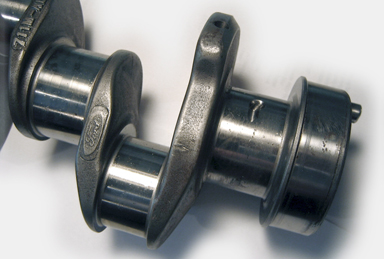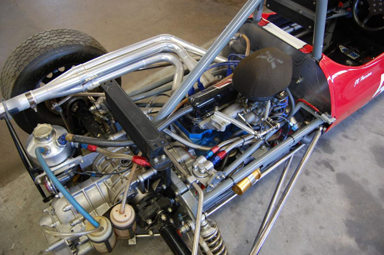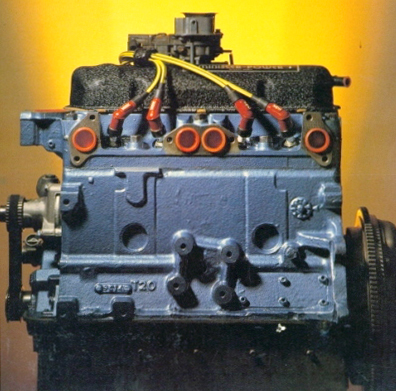Rebuilding a Formula Ford Engine
The Old Days
Historically the complete rebuilding of a Formula Ford engine was an annual exercise. At the end of each season or perhaps sooner - after something like 12 to 15 hours of running time - the engine was disassembled, inspected and rebuilt as necessary. But there are different degrees of rebuilding.
At the minimum, the engine is taken apart, key parts (crank, cam and rods) are magnafluxed and, if nothing major is found, new rings and bearings are all that's really needed - plus a head "freshening" or 'valve job'. At the other end of the spectrum the approach is to do a complete rebuild with the goal of returning the engine to absolutely top condition, with no compromises. This involves replacing anything that is even slightly out of spec which may include the crankshaft, cam & lifters, valves and pistons. The block might even be sleeved to achieve optimum piston to wall clearances.
Formula Ford has always had room for every imaginable approach to engine maintenance and that includes those who want to have their engine completely rebuilt professionally every year, those who are satisfied with a "freshening", as well as those who would rather do the work themselves, replacing a minimum of parts or, if necessary, performing a major rebuild. A 'casual' Regional competitor might simply disassemble their engine, have the major parts crack-checked and re-assemble it with new bearings and rings.
But there are factors which might call for a different approach entirely. National runners will often do a rebuild and/or swap out their engine mid-season, as soon as they detect that performance has fallen off. So if the usual top end touch-up does not bring things back to peak power - a leak-down test shows that the rings are no longer sealing well, for example - then it's time to pull the engine out and freshen it completely. For many top flight National racers, peak performance at every single event is the goal and there is no room for compromise.
 In Regional racing, almost everyone runs a full season on the bottom end unless there is some signal that it needs serious attention. Either bearing material is showing up in the oil or a leak-down test yields really poor results. Naturally, it all depends how much time is put on the engine and whether it's been run past the red line excessively. A guy who does, say, eight events a year is unlikely to put more than ten or twelve hours on an engine, perhaps fifteen hours maximum if a few test days are thrown into the mix.
In Regional racing, almost everyone runs a full season on the bottom end unless there is some signal that it needs serious attention. Either bearing material is showing up in the oil or a leak-down test yields really poor results. Naturally, it all depends how much time is put on the engine and whether it's been run past the red line excessively. A guy who does, say, eight events a year is unlikely to put more than ten or twelve hours on an engine, perhaps fifteen hours maximum if a few test days are thrown into the mix.
The timetable for the yearly re-build was, in great part, dictated by the necessity to take a look at the OEM crankshaft. Magnafluxing the original Ford crank annually provided cheap insurance and made a big blowup which could result from a failed crank far less likely. Several years ago then, the standing advice was never to put more than twenty hours on an engine before tearing it down and magging the crank. Some engine builders literally recommended that an OEM crank be retired after as few as ten hours running time! But things have changed!
The New Days of Longer Engine Life
Engines fitted with one of new new, stronger SCCA/SCAT crankshafts, the new forged aluminum pistons and SPS or ARP rod bolts can now be considered to have a bottom end life of over 50 hours before any major rebuild work is required. This assumes, of course, that the major components have been magnafluxed, balanced and properly assembled. One other point: some of the engine builders do further work on the SCAT crankshafts. Jay Ivey, for example, rechecks to confirm perfect balance and clearances and also has them shot peened.
Now that the newer, stronger aftermarket cranks are prevalent, the annual rebuild of the bottom end is not absolutely mandatory but is instead, elective surgery based on two main factors: first, the need to do what is required to maintain peak performance - good ring seal, low piston/wall clearances, good valve seal, good oil pressure via tight bearing clearances and so on; and secondly, the desire to assure the engine's longevity and reliability by doing a complete teardown to allow magnaflux inspection of the crankshaft, connecting rods and cam. Rod bolts are critical too but now the pretty much standard use of super high-strength 12 point bolts eliminates most concerns in that area.
So even if end-of-season disassembly, magnaflux inspection and replacement of rings and bearings is your choice, the new cranks and pistons will not need replacement for fifty hours - maybe longer. So as in many aspects of this sport, it's a question of three key issues - goals, expectations and budget. A full-blown rebuild involving cylinder block sleeving is only called for if absolutely top performance is the main priority. But there are other approaches too and a decision about when to take any given route requires "taking stock" in more ways than one!
 |
| This is about as perfect an engine bay as you will ever see! There are exceptionally fine finishes everywhere, well organized plumbing lines and well designed throttle linkage and fittings. In the long run this sort of high quality installation pays off. ( 1969 Macon ) |
"Home-Built" Engines
A "home-built" racing engine might be more properly referred to as a "home-assembled" engine. Throughout the history of the class, many FF racers have built up their own engines either because their budgets have not allowed for professionally built engines or, alternatively, they have simply preferred doing the engine work themselves for whatever reason. But in almost all cases, the key parts will be obtained from engine builders fully prepared and ready to bolt on. Only in rare cases would an amateur engine builder try to do all the required prep work on a cylinder head, intake manifold or carburetor. In general, that sort of work is very specialized so results are likely to fall short of expectations.
Fortunately, there are still a good number of racers who continue to build their own engines along with doing their own frame-up chassis rebuilds, chassis alignment and tuning, etc. That's part of what Formula Ford racing is all about. Do the guys who put together their own engines get less power output or less reliability? The answer is not necessarily - assuming the right parts are used and the machinework and balancing is done to high standards by a skilled racing machine shop. Since the FF engine rules are so restrictive, the resulting performance may not be far short of the professionally built example.
Race prepared parts that are readily available include:
- crankshafts
- cylinder heads
- connecting rods
- flywheels
- pistons
- rings
- carburetors
- distributors
- rockers arms
- intake manifolds
Formula Ford Engine Builders and Parts Sources
Several engine shops across the country specialize in building and rebuilding complete FF1600 engines. These shops can sell you a complete, fresh, dyno-tuned engine ready to be bolted in to your car or they can take your engine, completely disassemble it and rebuild it, replacing any tired parts and/or updating components like the cylinder head, carburetor, crankshaft, camshaft, valves or any other part that is preventing your engine from providing its full potential power putput.
The list includes:
- Ivey Engines
- Loynings Engine Service
- Quicksilver Engines
- Farley Engines
- Williams Engines
- Elite Engines
- Cricket Farm
- MWE Race Engines
Jay Ivey has taken the lead in the development of aftermarket parts for the Kent engine including forged pistons in standard and oversized forms, rocker towers and camshafts among other parts.
Aluminum Cylinder Head Tech Notes
courtesy of Curtis Boggs
(Originally posted on ApexSpeed. "RFD" refers to the name of Curtis' machine shop Race Flow Development; at which he specializes in cylinder heads.)
HEAD BOLT WASHERS
Yes you must use them. I now use a through hardened washer the same size as the head bolt pad on the head. Through hardened washers are made to resist bending and will spread the load across the entire pad. This will help with the bolt or washer digging into the head. Do not use a case hardened washer ( black finish ) and make sure the washer is the size of the pad, not just the size of the bolt head. It's a good idea to use a dab of oil or molly grease under the washer & head bolt.
ROCKER SHAFT STUDS
Again, yes, you must use them. Justice Race engines, Quicksilver, Britain West and Ivey all stock a stud kit for the rocker shaft. The aluminum threads can't hold just the bolt and the rocker shaft will flex. You'll loose a little power with the bolt but more important it'll wear the threads in the head. The stud kit eliminates the flex and protects the threads from damage. Keep in mind the when installing the studs you must first bottom tap the holes as the factory threads don't go all the way down.
VALVE CLEARANCE
I've heard everything here: setting hot, setting while the moon is full, etc. Since the aluminum head dissipates heat so fast I've been setting lash cold at .007" and .014". Seems to work for me. Ask your engine builder or try setting cold, then checking it hot to see where it moved.
CARB & CAM TUNING
If you change cylinder heads, you must re-jet the carb. On our little engines I don't think there's an easy answer. Jetting and working with the dump tubes I feel needs to be done on a dyno with EGT's by a pro builder to get maximum power. If you are going from a head built by any other porter to a RFD head you'll need to re-jet. Also cam timing needs to be tuned for max power. Think about it: the head is where the air flow is. The cam controls the air flow cycle through the engine; different head ports like different cam timing. A good starting number I have found is 113. This seems to net the best average HP numbers, and average HP makes lap time! I'm not an engine builder, so I'm not going to give any other advise in this area, .. Perhaps Justice, Sandy or Jay can post on this subject.
VALVE SEAT MAINTENANCE
The valve job is THE most important part of the head. Treat it like the gold it is. I've had a few heads come back where the owner had the local auto shop "touch up" the valve job. Take a seat grinding stone to my valve job and it'll KILL it! If the seats need work, send the head back to the person that built it, or to a pro engine builder. The between rebuild "touch up" should be done in two ways. Either just a light lap with 400 grit compound, and check the valves. If everything looks OK, go race, but the valves tend to get beat up. In that case a light cut on the valve face is okay but never take anything more then compound to the seat in the head. The seats on an RFD head are cut on a Serdi machine with a custom made cutter profile. I'm the only one with these cutters, so if your seats need to be touched up, they'll need to come here.
VALVE GUIDES
RFD uses a custom valve guide. If they are worn and need replacing contact the person who built the head as the guides are part of the port design and affect flow. CLEAN UP A few shops use a wire brush to clean carbon out of the ports. This is a bad idea! The finish in the ports - mostly the intake - is there for a reason. It needs to be that 60 grit sand paper finish to avoid fuel separation in the port. Wire brushes make the port too smooth. Also, heads I build are tuned on the flow bench, that often means as little as .050" is used in the "sweet spot" to tune a port, a wire brush could kill that critical shape.
I hope this info helps.
Curtis
Here's a general startup/break-in procedure for your "home built" engine.
Read more if you are looking to buy a Formula Ford engine.
